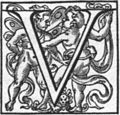On the Magnet/IV-3
CHAP. III.
The variation in any one place
is constant.
 nless there should be a great dissolution of a continent and a subsidence of the land such as there was of the region Atlantis of which Plato and the ancients tell, the variation will continue perpetually immutable; the arc of the variation remains the same in the same place or region, whether it be at sea or on land, as in times past a magnetick body has declined toward the East or the West. The constancy of the variation and the pointing of the versorium to a definite point on the horizon in individual regions is demonstrated by a small versorium placed over a terrella the surface of which is uneven: for it always deviates from the meridian by an equal arc. It is also shown by the inclination of a versorium toward a second magnet; although in reality it is by the turning power of the whole,
nless there should be a great dissolution of a continent and a subsidence of the land such as there was of the region Atlantis of which Plato and the ancients tell, the variation will continue perpetually immutable; the arc of the variation remains the same in the same place or region, whether it be at sea or on land, as in times past a magnetick body has declined toward the East or the West. The constancy of the variation and the pointing of the versorium to a definite point on the horizon in individual regions is demonstrated by a small versorium placed over a terrella the surface of which is uneven: for it always deviates from the meridian by an equal arc. It is also shown by the inclination of a versorium toward a second magnet; although in reality it is by the turning power of the whole,  whether in the earth or in a terrella. Place upon a plane a versorium whose cusp is directed toward the north A: place beside it a loadstone, B, at such a distance that the versorium may turn aside toward B to the point C, and not beyond. Then move the needle of the versorium as often as you will (the box and the loadstone not being moved), and it will certainly always return to the point C. In the same manner, if you placed the stone so that it may be truly directed toward E, the cusp always reverts to E, and not to any other point of the compass. Accordingly, from the position of the land and from the distinctive nature of the highest parts of the earth (certain terrene and more magnetick eminences of the regions prevailing), the variation indeed becomes definite in one and the same place, but diverse and unæqual from a change of place, since the true and polar direction originating in the whole terrestrial globe is diverted somewhat toward certain stronger eminences on the broken surface.
whether in the earth or in a terrella. Place upon a plane a versorium whose cusp is directed toward the north A: place beside it a loadstone, B, at such a distance that the versorium may turn aside toward B to the point C, and not beyond. Then move the needle of the versorium as often as you will (the box and the loadstone not being moved), and it will certainly always return to the point C. In the same manner, if you placed the stone so that it may be truly directed toward E, the cusp always reverts to E, and not to any other point of the compass. Accordingly, from the position of the land and from the distinctive nature of the highest parts of the earth (certain terrene and more magnetick eminences of the regions prevailing), the variation indeed becomes definite in one and the same place, but diverse and unæqual from a change of place, since the true and polar direction originating in the whole terrestrial globe is diverted somewhat toward certain stronger eminences on the broken surface.
